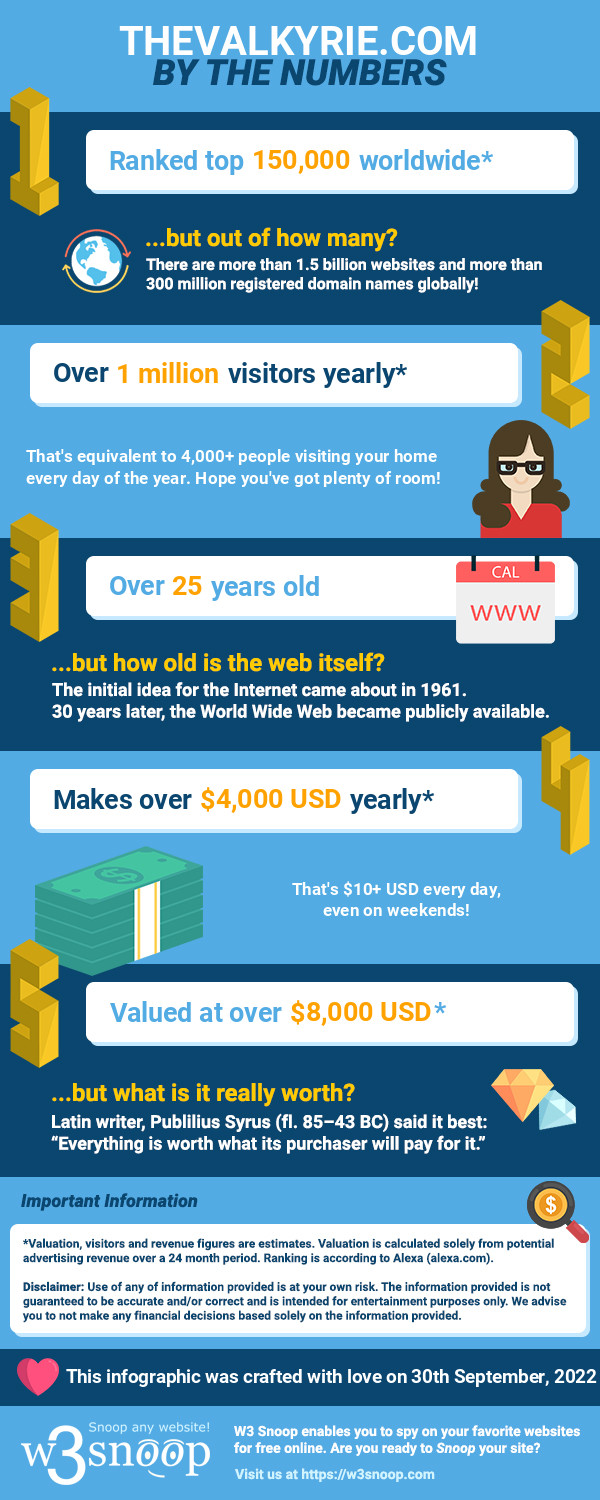thevalkyrie.com
Free website and domain report on thevalkyrie.com
Last Updated: 6th June, 2023
Update Now
Overview
Snoop Summary for thevalkyrie.com
This is a free and comprehensive report about thevalkyrie.com. The domain thevalkyrie.com is currently hosted on a server located in Hull, England in United Kingdom with the IP address 212.58.55.194, where GBP is the local currency and the local language is English. Our records indicate that thevalkyrie.com is owned/operated by Statutory Masking Enabled. Thevalkyrie.com has the potential to be earning an estimated $13 USD per day from advertising revenue. If thevalkyrie.com was to be sold it would possibly be worth $9,605 USD (based on the daily revenue potential of the website over a 24 month period). Thevalkyrie.com receives an estimated 4,612 unique visitors every day - a large amount of traffic! This report was last updated 6th June, 2023.
About thevalkyrie.com
| Site Preview: | |
| Title: | Diana The Valkyrie |
| Description: | The place for everyone interested in Valkyries, amazons, strong women, fighting women and female bodybuilders. Stories, pictures, video clips, message boards and a chat room |
| Keywords: | valkyries, amazons, female muscle, strong women, fighting women, female bodybuilders, tall women, scissors, mixed fighting, mixed wrestling, lift and carry |
| Popular Terms: | |
| Fav Icon: | |
| Tags and Categories: | adult content, personal pages |
| Age: | Over 26 years old |
| Domain Created: | 24th May, 1997 |
| Domain Updated: | 28th January, 2020 |
| Domain Expires: | 23rd May, 2025 |
Review
Snoop Score
3/5 (Great!)
Valuation
$9,605 USD
Note: All valuation figures are estimates.
Popularity
Modest
Note: Popularity is estimated.
Rank, Reach and Authority
| Alexa Rank: | 131,471 |
| Alexa Reach: | |
| SEMrush Rank (US): | (View worldwide rankings) |
| SEMrush Authority Score: | |
| Moz Domain Authority: | 0 |
| Moz Page Authority: | 0 |
Organic vs Paid (Google Ads)
Alexa Graphs
Rank (12 Month Period) ![Alexa Rank Graph (12 Month Period) Alexa Rank Graph for thevalkyrie.com]()
Search (12 Month Period) ![Alexa Search Graph (12 Month Period) Alexa Search Graph for thevalkyrie.com]()
Traffic
Visitors
| Daily Visitors (Unique): | 4,612 |
| Monthly Visitors (Unique): | 140,375 |
| Yearly Visitors (Unique): | 1,683,380 |
Note: All visitors figures are estimates.
Visitors By Country
Revenue
Revenue
| Daily Revenue: | $13 USD |
| Monthly Revenue: | $400 USD |
| Yearly Revenue: | $4,798 USD |
Note: All revenue figures are estimates.
Revenue By Country
SEO
Backlinks Analysis (SEMrush)
Top New Follow Links
Top Ranking Keywords (US)
Domain Analysis
| Value | Length | |
|---|---|---|
| Domain: | thevalkyrie.com | 15 |
| Domain Name: | thevalkyrie | 11 |
| Extension (TLD): | com | 3 |
| Expiry Check: | |
Page Speed Analysis
| Average Load Time: | 1.23 seconds |
| Load Time Comparison: | Faster than 69% of sites |
PageSpeed Insights
Hosting
Server Location
| Server IP Address: | 212.58.55.194 |
| Continent: | Europe |
| Country: | United Kingdom |
| Region: | England |
| City: | Hull |
| Longitude: | -0.3005 |
| Latitude: | 53.7678 |
| Currencies: | GBP |
| Languages: | English |
Web Hosting Provider
| Name | IP Address |
|---|---|
| internet Privacy Ltd |
Registration
Domain Registrant
| Private Registration: | No |
| Name: | Statutory Masking Enabled |
| Organization: | Statutory Masking Enabled |
| Country: | CY |
| City: | Statutory Masking Enabled |
| State: | --- Please select --- |
| Post Code: | Statutory Masking Enabled |
| Email: | abuse@web.com |
| Phone: | Statutory Masking Enabled |
Note: Registration information is derived from various sources and may be inaccurate.
Domain Registrar
| Name | IP Address |
|---|---|
| Network Solutions, LLC | 162.159.133.53 |
Security
Visitor Safety
| Mature Content: | |
| McAfee WebAdvisor Rating: | |
| WOT Rating: | |
| WOT Trustworthiness: | 66/100 |
| WOT Child Safety: | 10/100 |
Note: Safety information is not guaranteed.
SSL/TLS Certificate
| Issued To: | *.thevalkyrie.com |
| Issued By: | R3 |
| Valid From: | 23rd August, 2022 |
| Valid To: | 21st November, 2022 |
| Subject: | CN = *.thevalkyrie.com |
| Hash: | b2cf3de0 |
| Issuer: | CN = R3 O = Let's Encrypt S = US |
| Version: | 2 |
| Serial Number: | 0x038A1D48AD22543E5DB3A5E1850220E29CC5 |
| Serial Number (Hex): | 038A1D48AD22543E5DB3A5E1850220E29CC5 |
| Valid From: | 23rd August, 2023 |
| Valid To: | 21st November, 2023 |
| Signature Algorithm (Short Name): | RSA-SHA256 |
| Signature Algorithm (Long Name): | sha256WithRSAEncryption |
| Authority Key Identifier: | keyid:14:2E:B3:17:B7:58:56:CB:AE:50:09:40:E6:1F:AF:9D:8B:14:C2:C6 |
| Extended Key Usage: | TLS Web Server Authentication, TLS Web Client Authentication |
| Certificate Policies: | Policy: 2.23.140.1.2.1 Policy: 1.3.6.1.4.1.44947.1.1.1 CPS: http://cps.letsencrypt.org |
| Authority Information Access: | OCSP - URI:http://r3.o.lencr.org CA Issuers - URI:http://r3.i.lencr.org/ |
| SCT List: | Signed Certificate Timestamp: Version : v1 (0x0) Log ID : 6F:53:76:AC:31:F0:31:19:D8:99:00:A4:51:15:FF:77: 15:1C:11:D9:02:C1:00:29:06:8D:B2:08:9A:37:D9:13 Timestamp : Aug 23 08:58:47.611 2022 GMT Extensions: none Signature : ecdsa-with-SHA256 30:44:02:20:32:B0:6C:2D:C5:98:D3:7F:CD:DC:E8:81: 60:66:D4:AA:81:80:22:08:E6:AE:01:54:21:69:C5:B5: A6:FB:13:78:02:20:46:D5:8D:D3:54:22:2F:CF:41:CD: D2:7F:B4:94:37:5C:3E:52:83:C3:61:12:5F:BC:E2:B9: 5D:1D:62:26:1F:0F Signed Certificate Timestamp: Version : v1 (0x0) Log ID : 46:A5:55:EB:75:FA:91:20:30:B5:A2:89:69:F4:F3:7D: 11:2C:41:74:BE:FD:49:B8:85:AB:F2:FC:70:FE:6D:47 Timestamp : Aug 23 08:58:47.639 2022 GMT Extensions: none Signature : ecdsa-with-SHA256 30:44:02:20:25:1C:0D:68:71:BE:C9:08:2E:33:5B:52: 2A:2F:FA:9B:E7:05:8B:98:B6:22:17:C0:DB:4D:6A:41: 7A:20:75:9B:02:20:67:AB:2A:7E:6F:68:30:41:0A:C1: 14:60:3A:35:4A:63:3A:5D:14:E2:D2:0E:8D:C9:84:8B: EA:63:29:F2:EE:CD |
| Key Usage: | Digital Signature, Key Encipherment |
| Basic Constraints: | CA:FALSE |
| Subject Alternative Name: | DNS:thevalkyrie.com DNS:*.thevalkyrie.com |
Technical
DNS Lookup
A Records
| Host | IP Address | Class | TTL |
|---|---|---|---|
| thevalkyrie.com. | 212.58.55.194 | IN | 3600 |
NS Records
| Host | Nameserver | Class | TTL |
|---|---|---|---|
| thevalkyrie.com. | maire.thevalkyrie.com. | IN | 3600 |
| thevalkyrie.com. | volds.thevalkyrie.com. | IN | 3600 |
MX Records
| Priority | Host | Server | Class | TTL |
|---|---|---|---|---|
| 100 | thevalkyrie.com. | mail2.thevalkyrie.com. | IN | 3600 |
| 300 | thevalkyrie.com. | mail1.thevalkyrie.com. | IN | 3600 |
| 200 | thevalkyrie.com. | mail1.thevalkyrie.com. | IN | 3600 |
SOA Records
| Domain Name | Primary NS | Responsible Email | TTL |
|---|---|---|---|
| thevalkyrie.com. | maire.thevalkyrie.com. | valkyrie.thevalkyrie.com. | 3600 |
TXT Records
| Host | Value | Class | TTL |
|---|---|---|---|
| thevalkyrie.com. | v=spf1 | IN | 3600 |
HTTP Response Headers
| HTTP-Code: | HTTP/1.1 200 OK |
| Date: | 30th September, 2022 |
| Server: | Apache |
| Content-Type: | text/html |
| X-Frame-Options: | DENY |
| Content-Security-Policy: | default-src 'self' https://www.thevalkyrie.com http://www.thevalkyrie.com |
| X-Xss-Protection: | 1; mode=block |
| Referrer-Policy: | no-referrer |
| X-Content-Type-Options: | nosniff |
| Strict-Transport-Security: | max-age=31536000; includeSubDomains |
| Accept-Ranges: | bytes |
| Content-Length: | 2302 |
Whois Lookup
| Created: | 24th May, 1997 |
| Changed: | 28th January, 2020 |
| Expires: | 23rd May, 2025 |
| Registrar: | Network Solutions, LLC |
| Status: | clientTransferProhibited |
| Nameservers: | ns1.dianathevalkyrie.com ns1.thevalkyrie.com ns2.dianathevalkyrie.com ns2.thevalkyrie.com ns3.thevalkyrie.com ns4.thevalkyrie.com ns5.thevalkyrie.com ns6.thevalkyrie.com |
| Owner Name: | Statutory Masking Enabled |
| Owner Organization: | Statutory Masking Enabled |
| Owner Street: | Statutory Masking Enabled |
| Owner Post Code: | Statutory Masking Enabled |
| Owner City: | Statutory Masking Enabled |
| Owner State: | bucks |
| Owner Country: | UK |
| Owner Phone: | Statutory Masking Enabled |
| Owner Email: | abuse@web.com |
| Admin Name: | Statutory Masking Enabled |
| Admin Organization: | Statutory Masking Enabled |
| Admin Street: | Statutory Masking Enabled |
| Admin Post Code: | Statutory Masking Enabled |
| Admin City: | Statutory Masking Enabled |
| Admin State: | Statutory Masking Enabled |
| Admin Country: | Statutory Masking Enabled |
| Admin Phone: | Statutory Masking Enabled |
| Admin Email: | abuse@web.com |
| Tech Name: | Statutory Masking Enabled |
| Tech Organization: | Statutory Masking Enabled |
| Tech Street: | Statutory Masking Enabled |
| Tech Post Code: | Statutory Masking Enabled |
| Tech City: | Statutory Masking Enabled |
| Tech State: | Statutory Masking Enabled |
| Tech Country: | Statutory Masking Enabled |
| Tech Phone: | Statutory Masking Enabled |
| Tech Email: | abuse@web.com |
| Billing Name: | Statutory Masking Enabled |
| Billing Organization: | Statutory Masking Enabled |
| Billing Street: | Statutory Masking Enabled |
| Billing Post Code: | Statutory Masking Enabled |
| Billing City: | Statutory Masking Enabled |
| Billing State: | Statutory Masking Enabled |
| Billing Country: | Statutory Masking Enabled |
| Billing Phone: | Statutory Masking Enabled |
| Billing Fax: | Statutory Masking Enabled |
| Billing Email: | abuse@web.com |
Nameservers
| Name | IP Address |
|---|---|
| ns1.dianathevalkyrie.com | 212.58.55.198 |
| ns1.thevalkyrie.com | 212.58.55.195 |
| ns2.dianathevalkyrie.com | 212.58.55.198 |
| ns2.thevalkyrie.com | 212.58.55.198 |
| ns3.thevalkyrie.com | 212.58.55.195 |
| ns4.thevalkyrie.com | 212.58.55.198 |
| ns5.thevalkyrie.com | 212.58.55.195 |
| ns6.thevalkyrie.com | 212.58.55.198 |
Related
Subdomains
Similar Sites
| Domain | Valuation | Snoop Score |
|---|---|---|
| $1,034 USD | 1/5 | |
| $14,020 USD | 3/5 | |
| $776 USD | 1/5 | |
| $10,762 USD | 2/5 | |
| $609 USD | 1/5 |
Organic Search (US) Competitors
Backlink Competitors
Sites with the same domain name
Sites hosted on the same IP address
| Domain | Valuation | Snoop Score |
|---|---|---|
| 0/5 | ||
| $1,034 USD | 1/5 | |
| $6,670 USD | 3/5 | |
| $2,538 USD | 2/5 |




